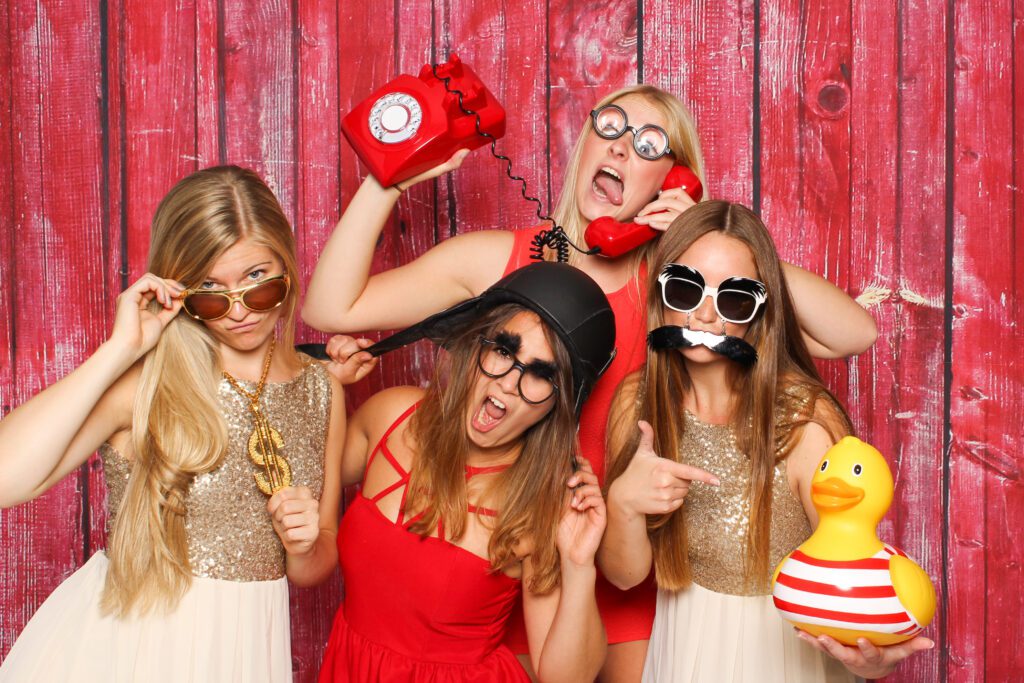

Without a doubt, photo booths have come a long way in recent years. The earliest concept of a photo booth was first introduced at the 1889 Paris World’s Fair with a coin-operated machine that could produce a photo transferred onto a thin sheet of metal in 5 minutes. The concept wouldn’t hit the United States until the late 1920s when it was called a Photomaton. Everything at first was printed in black and white, and it would take another 40 years before the photo booth was able to offer color photos. And, of course, it took a while after that before the terms “digital” or “social media posts” became a part of the common photo booth language.
Like so many other popular inventions, the photo booth has changed dramatically since its humble origins, and technology has only made it better. Today, photo booths are enormously popular at social gatherings, whether it’s an office party, wedding, bar mitzvah, pool party, or holiday gathering. Today, anyone who uses a photo booth can instantly share their photos with millions of people around the globe, courtesy of social media.
How Did the Photo Booth First Get Invented?
The first patent for the “Auto-Photo” was in 1889. At the Paris World’s Fair, a coin-operated device was introduced that could make an exposure and deliver a framed ferrotype — a photo transferred onto a thin sheet of metal — in 5 minutes. However, the magazine La Nature would write, “A portrait could barely be seen and was often unrecognizable.”
From those humble beginnings, the Auto-Photo started to get better, and the technology would make its way to the United States in 1925 when a Siberian immigrant named Anatol Josepho unveiled a fully-automatic photographic machine near New York City’s Times Square. This was a significant advancement from the first automatic photo booth introduced in 1896 in Germany, which included a negative and positive process.
Calling it the Photomaton, Josepho discovered he had a hit, with people lining up for blocks and waiting hours for a chance to have their image captured in a photo. It was also the first curtain-enclosed photo booth in New York City. The difference between the Auto-Photo and the Photomaton was that Josepho had discovered a way to print much higher-quality images. Back then, it took about 8 minutes to process your photos.
The automated photo booth saw a decline but has experienced a resurgence in modern times, impacting popular culture and becoming relevant in contemporary events and gatherings.
How Did Photo Booths Become So Popular?
Within the next few decades, photo booths spread across the United States, Canada, and Europe, and whenever they popped up, people flocked to them. That included everyone from regular folks to actors, celebrities, and even presidents.
Artists in particular became fascinated with photo booths. The surrealist Salvador Dali and the film director Luis Bunuel produced self-portraits using photo booths. Artist Andy Warhol did the same in the 1960s, incorporating photo booths into his art. In 1968, users could start operating the photo booth themselves, without the need for an attendant who would adjust the lens and recommend how people should pose for their pictures.
By the 1970s, the technology had improved and color had replaced black & white ink. After that, the next revolution came in the 1990s, when a company called Photo-Me introduced digital color photo booths using a computer to print the strips. The photo booth had entered the high-tech age.
Today, photo booths are popular for providing instant digital photos that can be emailed to you and then shared within seconds on social media sites. It’s safe to say the earliest innovators never expected terms like smartphone, Instagram or likes and shares would play such an important role in why we all love photo booths. The modern 360 photo booth experience captures photos in a way that blends nostalgia with cutting-edge technology, making it a unique and cherished activity for all ages.
The Evolution of Technology for Photo Booths
For a succinct overview of the history of the photo booth, here are key dates:
1925: The Birth of the Photo Booth
The first photo booth debuts in New York City, invented by Anatol Josepho by using a complex mechanical system of gears, pulleys, and timers.
Early photo booths produce black-and-white images, taking several minutes to develop and print.
1960s: Transition to Color
Photo booths begin to adopt color photography, requiring significant changes in chemical processes. Color photo booths also start to attract more users with their vibrant, lifelike images despite higher costs and complexity.
Late 20th Century: Digital Revolution
Digital cameras and printers replace traditional film and chemical processes, and modern digital photo booths emerge, equipped with state-of-the-art cameras, lighting, and software.
Users can also preview and print photos instantly, with options to add digital effects and filters. Despite the rise of digital sharing, printed photos remain an option for those who prefer physical copies.
Early 21st Century: Social Media Integration
Photo booths are equipped with touch screens and software for instant social media sharing. Also, features such as green screen backgrounds, animated gifs, and video messaging become standard.
2010s: Customization and Personalization
Customizable backgrounds, logos, and messages make photo booths popular at weddings, parties, and corporate events. Some photo booths offer augmented reality features, allowing users to interact with virtual elements.
Looking Ahead: Future Innovations
Future photo booths may incorporate AI and facial recognition for more personalized experiences. Also, continued advancements in augmented reality could make photo booths more immersive and interactive.
This timeline format highlights the key milestones in the evolution of photo booth technology, showcasing how these beloved machines have adapted and thrived through the decades.
Choose A Cut Above Photo Booth for Your Next Event
If you’re ready to plan a party or other social gathering that your guests and employees will love, choose a next-generation photo booth from A Cut Above Photo Booth. We’re proud to provide custom photo booths for weddings, parties, and corporate events. Choose our magic mirror photo booth in Orlando, FL which blends in with its surroundings, which you then can custom-brand to stand out at your event.
To get a head start on planning the most memorable event of the year, give us a call at (800) 295-0430 today or visit us online to reserve your date!
FAQ: The History of Photo Booths
How did early photo booths work?
Early photo booths were entirely mechanical, using gears, pulleys, and timers to automate the process of taking and developing photos. Users would insert a coin, pose, and wait several minutes for a strip of black-and-white images to develop.
When did color photo booths become available?
Color photo booths started appearing in the 1960s. They required significant advancements in chemical processing to produce vibrant, lifelike color images.
What major technological shift occurred in photo booths in the late 20th century?
The late 20th century saw the advent of digital photography in photo booths. Digital cameras and printers replaced film, allowing for instant photo printing and the addition of digital effects and filters.
How have photo booths adapted to the rise of social media?
Modern photo booths are often equipped with touch screens, internet connectivity, and software that allows users to instantly share their photos on social media. Features like green screen backgrounds, animated gifs, and video messaging have become common.
What customization options are available in today’s photo booths?
Today’s photo booths offer a high degree of customization, including personalized backgrounds, logos, and messages. Some even offer augmented reality features, allowing users to interact with virtual elements in their photos.
How have smartphones impacted the photo booth industry?
Despite the ubiquity of smartphones, photo booths have remained popular by evolving with new technologies and offering unique experiences that smartphones cannot, such as physical photo strips and advanced customization options.
What are some predicted future advancements for photo booths?
Future advancements may include artificial intelligence, facial recognition, and enhanced augmented reality features, making photo booths even more personalized and interactive.
Why did photo booths become a cultural phenomenon?
Photo booths became a cultural phenomenon due to their novelty, affordability, and the instant gratification of receiving a printed photo. They were popular in public spaces like malls, amusement parks, and train stations, becoming a staple of social gatherings and events.

